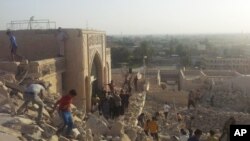A group of Iraqi archaeologists who visited a historic site in the eastern part of war-torn Mosul to document its destruction by so-called Islamic State (IS) claim to have discovered an ancient palace beneath the ground which is 2,500 years old.
Last month, a group of archaeologists from Iraq’s Antiquities Department visited the site known as "Jonah Shrine" to conduct a damage assessment after IS’s withdrawal from the area. The group was astonished to find several relics that they claim belong to a king of the Neo-Assyrian Empire who ruled from 669 to 681 B.C.
“We discovered a big marble cuneiform inscription of King Esarhaddon, a stone sculptures of Assyrian goddess, pieces of famous wall decoration, and most amazingly the statue of a winged bull. The discovery took us by surprise,” archeologist Layla Salih, who led the group, told VOA.
She added that IS fighters have dug tunnels deep into the ground and possibly found some relics.
“The pieces we found are big and there is a great possibility that IS stole the smaller pieces that were easy to transport,” Salih said.
The shrine is considered one of the most prominent archeological sites in Mosul and is said to have housed the tomb of Prophet Jonah, a key figure in Judaism, Christianity and Islam.
It also hosted an Assyrian temple believed to have been built around 1300 B.C. and a mosque that was built about four centuries ago during the Ottoman Empire.
The unique history of the shrine and collection of the buildings in the site attracted many Christian and Muslim tourists to visit over the years.
IS destroyed and stole
IS captured it in July of 2014 and destroyed it with explosives. The destruction of Jonah’s Shrine and other cultural sites sparked global outrage and criticism.
“The need for action is paramount. Iraqi cultural sites, like Jonah’s Tomb in Mosul, Assyrian Palaces, churches and other monuments, are being destroyed and looted,” the U.N. Educational, Scientific and Cultural Organization (UNESCO) said in a statement. The statement added that pillaged goods from these cultural sites would be trafficked illegally into international markets.
After Islamic State’s withdrawal from the area last month, Iraqi forces went to the site to protect it from further destruction.
Zuhair al-Jbouri, a spokesperson of the National Mobilization Forces told VOA the entire site has been razed to the ground by IS fighters.
“IS has not only demolished this valuable shrine, but it has also dug several tunnels under it in search for artifacts,” Zuhair al-Jbouri said.
But Iraqi archaeologists are excited about the new discovery of an ancient palace and believe that the site would be more attractive for potential tourists in the future. They said more surveys would be planned and conducted to further explore the area.
“We saw the incredible artifacts only in the tunnels, but I can imagine a professional excavation can lead to even more amazing discoveries,” Iraqi archeologist Salih told VOA.
Further study needed
She said continued instability has impeded efforts of archeologists to conduct a comprehensive survey of the historic site to unveil new findings.
“The first major discovery in the site was in 1989. But since the 2003 U.S. invasion, Mosul has been unstable and archeologists have refrained from further investigating these historic places,” she added.
Salih’s team are also concerned that continued fighting between IS and the Iraqi forces in nearby neighborhoods of Mosul could further damage the site.
“The tunnels are dug unprofessionally and continue to collapse from bombing. The last time I went again to further investigate the site I was not able to enter one of the tunnels as it was filled with rubble,” she said.
Salih said Iraq’s Antiquities Department considered removing the pieces to prevent their further damage, but the artifacts are not easily transportable due to their size and lack of security in the area.
“My only hope is that these valuable pieces stay untouched for the time being. The site has no security protection and it is available for anyone to enter. They can easily be destroyed or stolen.”
Iraqi archeologists are hopeful that future excavation of the site will unveil new facts about the ancient palace and will provide a better window in to the past in terms of how art was viewed and appreciated thousands of years ago.
For that to happen they demand local authorities safeguard the site and provide it with adequate security to prevent its further destruction amid continued fighting in the surrounding areas.




